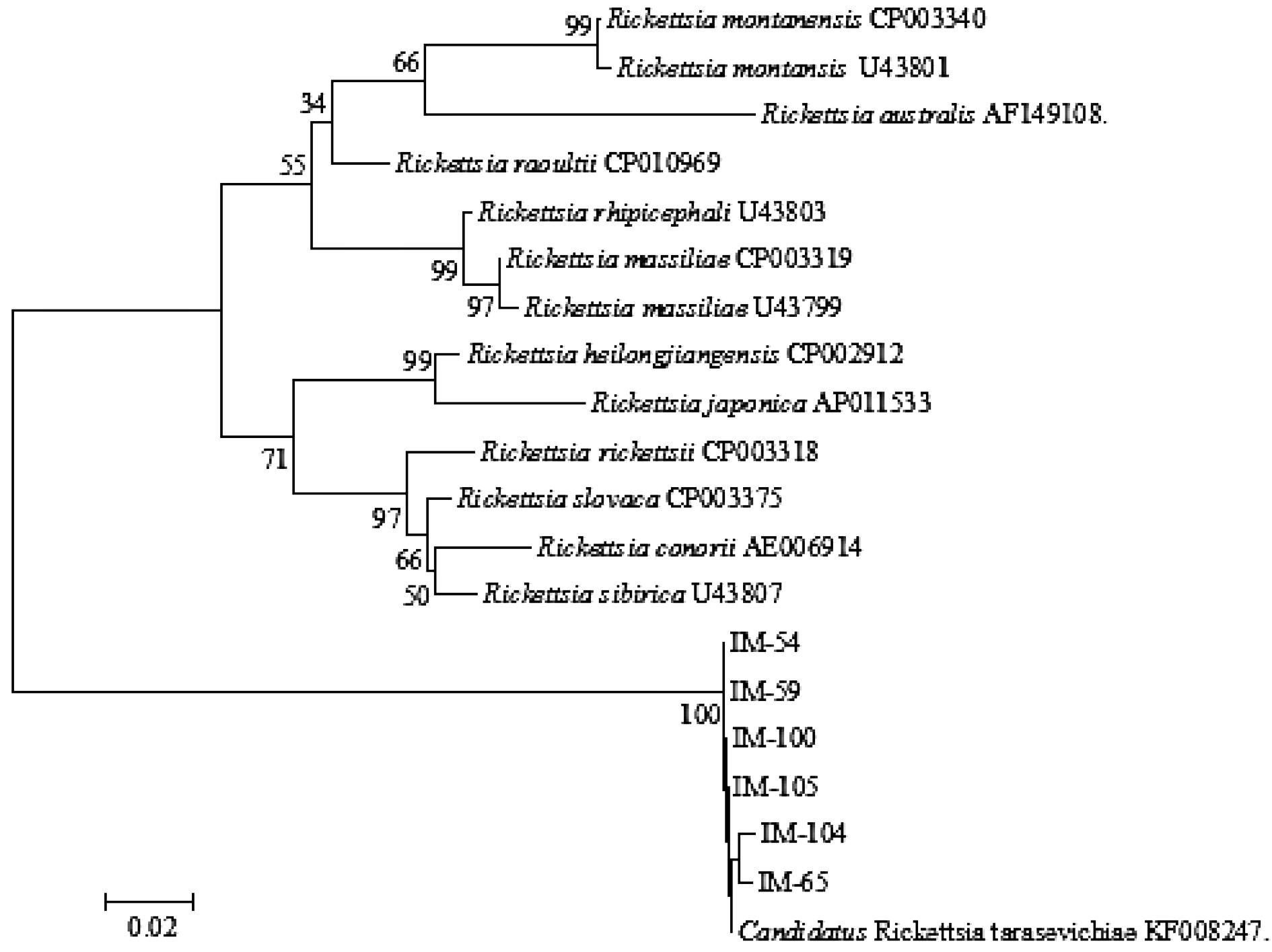Pathogen investigation of rodents in the western ground crossings of inner Mongolia
-
摘要:
目的 对内蒙古西部二连浩特口岸、策克口岸、鄂尔多斯口岸三个主要口岸地区开展流行病学调查, 调查该地区鼠的种类、分布状况以及携带的主要病原体, 为做好国门口岸地区疾病防控提供基础数据。 方法 确定调查地点并采用夹夜法进行捕鼠; 对监测区内所获得鼠分类鉴定并解剖取各种脏器, 针对鼠疫杆菌、巴贝西原虫、巴尔通体、斑点热群立克次体、无形体、伯氏疏螺旋体6种病原体进行特异性PCR检测; 用MAGA 5.0分析软件, 采用Bootstrap方法1 000次重复分析使可信性叠加, 基于目的基因序列构建Neighbor-joining树图。 结果 本次调查在三个口岸捕获长爪沙鼠、达乌尔黄鼠、子午沙鼠、五趾跳鼠、三趾跳鼠、小家鼠、灰仓鼠、小毛足鼠8种共178只; 有四种病原体包括巴尔通体、斑点热群立克次体、无形体、伯氏疏螺旋体检出阳性核酸片段, 阳性率分别为43.26%、6.18%、17.98%和3.37%;核苷酸序列分析发现该地区存在Candidatus Rickettsia tarasevichiae斑点热群立克次体和多种无形体。 结论 内蒙古西部口岸地区, 鼠种丰富, 鼠类携带病原体种类较多, 在今后的防控工作中要加强防范。 Abstract:Objective To investigate the rodent species, their distribution and pathogens carried by rodents in Erenhot, Ceke and Erdos ground crossings in western part of Inner Mongolia, and to provide basic information for disease prevention in ground crossings area. Methods The study areas were de-termined where the rodents were captured and sacrificed for the nucleic acids extraction and tests for Yersinia pestis, Babesi protozoa, Bartonella, Spotted fever group rickettsia, anaplasmosis and Borrelia burgdorferi. The obtained sequences were analyzed by using MAGA 5.0 software. Bootstrap analysis was uesd to analyze the obtained nucleotide fragments of 1 000 repeats, and the neighbor joining tree was constructed based on the target gene sequence. Results Totally 8 rodents species were captured in the studied areas, including Long-clawed gerbil, Daur chinchilla, meridian gerbil, five-toed lemming, three-toed hamster, house mouse, gray hamster, hairy foot mouse. And a total of 4 nucleic acid positive materials has been detected, including Bartonella, Spotted fever group rickettsia, anaplasmosis, and Borrelia burgdorferi. The positive rate was 43.26%, 6.18%, 17.98% and 3.37%; With further analyzing of Nucleotide sequence, there were Candidatus Rickettsia tarasevichiae and several anaplasmosis in the district. Conclusions There were abundant species of rodents and many pathogens carried by rodents in the ground crossings of western area of Inner Mongolia. It should be focused on the prevention and control issues in future work. -
Key words:
- Inner Mongolia /
- Ground crossings /
- Rodent /
- Pathogen
-
表 1 病原体的引物信息及反应条件(退火温度)
Table 1. Primer information and reaction conditions of pathogens (annealing temperature)
病原体 引物名称 序列 长度(bp) 退火温度(℃) 巴贝西原虫 Bab1 5'-CTTAGTATAAGCTTTTATACAGC-3' 29 54 Bab4 5'-ATAGGTCAGAAACTTGAATGATACA-3' 31 Bab2 5'-GTTATAGTTTATTTGATGTTCGTTT-3' 31 54 Bab3 5'-AAGCCATGCGATTCGCTAAT-3' 26 伯氏疏螺旋体 RRS189F 5'-TGATGAAAGGAAGCCTTTAAAGCTTCGCTTG-3' 37 54 RRS828R 5'-CACCAAGTGTGCATCGTTTACAGCG-3' 31 RRS766R 5'-GCTTTCGTGACTCAGCGTCAGTCTT-3' 31 54 RRS442F 5'-GAGGAATAAGCTTTGTAGGAAATGAC-3' 32 斑点热立克次体 ROP 5'-ATGGCGAATATTTCTCCAAAA-3' 21 54 ROI 5'-GTTCCGTTAATGGCAGCATCT-3' 21 38s1 5'-AAAACCGCTTTATTCACC-3' 18 54 384r1 5'-GGCAACAAGTTACCTCCT-3' 18 无形体 Ehout1 5'-TTGAGAGTTTGATCCTGGCTCAGAACG-3' 33 54 Ehout2 5'-CACCTCTACACTAGGAATTCCGCTATC-3' 33 Ehgs1 5'-GTAATAACTGTATAATCCCTG-3' 27 54 Ehgs2 5'-GTACCGTCATTATCTTCCCTA-3' 27 巴尔通体 302p 5'-CCTTCGTTTCTCTTTCTTCA-3' 20 55 473n 5'-AACCAACTGAGCTACAAGCC-3' 20 311p 5'-CTCTTTCTTCAGATGATGATCC-3' 22 55 448n 5'-GGATAAACCGGAAAACCTTC-3' 20 鼠疫 CafI F 5'-AGTTCCGTTATCGCCATTGC-3' 20 56 CafI R 5'-ACAGTATGTGCTAGTGGTCC-3' 20 plaF 5'-CATTATGTGCATCTGCCTGGC-3' 21 56 plaR 5'-ATCCTGTTTGCTTCGCTGACC-3' 21 表 2 内蒙古西部地区三个口岸鼠种分布比较[n (%)]
Table 2. Comparison of rat species distribution at three ground crosings in western Inner Mongolia [n (%)]
鼠种 二连浩特 策克 鄂尔多斯 长爪沙鼠 89(80.18) 0(0.00) 0(0.00) 达乌尔黄鼠 8(7.21) 0(0.00) 0(0.00) 五趾跳鼠 3(2.70) 8(13.56) 0(0.00) 子午沙鼠 7(6.31) 43(72.88) 8(100.00) 三趾跳鼠 1(0.90) 4(6.78) 0(0.00) 小家鼠 2(1.80) 0(0.00) 0(0.00) 灰仓鼠 1(0.90) 0(0.00) 0(0.00) 小毛足鼠 0(0.00) 4(6.78) 0(0.00) 合计 111(100.00) 59(100.00) 8(100.00) 表 3 内蒙古西部地区三个口岸病原体检出结果[n (%)]
Table 3. Results of pathogen detection at three ports in western Inner Mongolia[n (%)]
病原种类 二连浩特(n=111) 策克(n=59) 鄂尔多斯(n=8) 合计(n=178) 鼠疫杆菌 0(0.00) 0(0.00) 0(0.00) 0(0.00) 斑点热立克次体 11(9.91) 0(0.00) 0(0.00) 11(6.18) 无形体 4(3.60) 28(47.46) 0(0.00) 32(17.98) 伯氏疏螺旋体 4(3.60) 2(3.39) 0(0.00) 6(3.37) 巴尔通体 50(45.05) 19(32.2) 8(100.00) 77(43.26) 巴贝西原虫 0(0.00) 0(0.00) 0(0.00) 0(0.00) 表 4 内蒙古西部地区三个口岸不同鼠种携带病原体检测结果[n (%)]
Table 4. Detection results of pathogens carried by different mouse species at three ports in western Inner Mongolia [n (%)]
鼠种 例数(n) 不同病原体阳性率 伯氏疏螺
旋体斑点热群
立克次体巴尔通体 无形体 达乌尔黄鼠 8 0(0.00) 4(50.00) 7(87.5) 4(50.00) 灰仓鼠 1 0(0.00) 0(0.00) 1(100.00) 0(0.00) 三趾跳鼠 5 1(20.00) 0(0.00) 1(20.00) 1(20.00) 五趾跳鼠 11 0(0.00) 1(9.09) 2(18.18) 2(18.18) 小家鼠 2 0(0.00) 0(0.00) 0(0.00) 0(0.00) 小毛足鼠 4 1(25.00) 0(0.00) 1(25.00) 2(50.00) 长爪沙鼠 89 4(4.49) 5(5.62) 35(39.33) 0(0.00) 子午沙鼠 58 0(0.00) 1(1.72) 30(51.72) 23(39.66) 合计 178 6(3.37) 11(6.18) 77(43.26) 32(17.98) 表 5 内蒙古西部地区三个口岸不同鼠种复合感染检测结果[n (%)]
Table 5. Detection results of coinfection by different mouse species at three ports in western Inner Mongolia [n (%)]
鼠种 例数(n) 不同病原体复合感染阳性率 a+b b+c c+d a+d b+c+d 达乌尔黄鼠 8 0(0.00) 3(37.50) 2(25.00) 0(0.00) 1(12.50) 灰仓鼠 1 0(0.00) 0(0.00) 0(0.00) 0(0.00) 0(0.00) 三趾跳鼠 5 0(0.00) 0(0.00) 0(0.00) 1(20.00) 0(0.00) 五趾跳鼠 11 0(0.00) 1(9.09) 0(0.00) 0(0.00) 0(0.00) 小家鼠 2 0(0.00) 0(0.00) 0(0.00) 0(0.00) 0(0.00) 小毛足鼠 4 0(0.00) 0(0.00) 0(0.00) 1(25.00) 0(0.00) 长爪沙鼠 89 1(1.12) 3(3.37) 0(0.00) 0(0.00) 0(0.00) 子午沙鼠 58 0(0.00) 1(1.72) 10(17.24) 0(0.00) 0(0.00) 合计 178 1(0.56) 8(4.49) 12(6.74) 2(1.12) 1(0.56) 注:a:表示伯氏疏螺旋体;b:表示斑点热立克次体;c:表示巴尔通体;d:表示无形体。 -
[1] 刘纪有, 张万荣.内蒙古鼠疫[M].呼和浩特: 内蒙古人民出版社, 1997: 151.Liu JY, Zhang WR. Inner Mongolia plague[M]. Hohhot: Inner Mongolia people's publishing house, 1997: 151. [2] 斯勤夫, 安格日格, 彭斯格.蒙古人民共和国自然疫源性疾病防治研究工作的过去、现况和发展目标[J].口岸卫生控制, 1996, (1): 45-48. http://www.cqvip.com/Main/Detail.aspx?id=10049518Steff, Angrige, Pongge. Past, present and development goals of research on prevention and treatment of natural infectious diseases in the People's Re-public of Mongolia[J]. Port Health Control, 1996, (1): 45-48. http://www.cqvip.com/Main/Detail.aspx?id=10049518 [3] 耶·波·高鲁宾斯基, 特·衣·园诺肯奇耶娃, 斯·夫·巴拉赫诺夫, 等.蒙古国鼠疫自然疫源地概况[J].地方病通报, 1999, 14(1): 35-36.DOI: 10. 3969/j. issn. 1000-3711. 1999. 01. 014.Gorubinsky YB, Yuenokenchieva TY, S f Barakhenov SF, et al. Overview of the natural foci of bubonic plague in Mongolia[J]. Endemic Dis Bull, 1999, 14(1): 35-36. DOI: 10. 3969/j. issn. 1000-3711. 1999. 01. 014. [4] Nicolas V, Quérouil S, Verheyen E, et al. Mitochondrial phylogeny of African wood mice, genus Hylomyscus(Rodentia, Muridae): implications for their taxonomy and biogeography[J]. Mol Phylogenet Evol, 2006, 38(3): 779-793.DOI: 10. 1016/j. ympev. 2005. 11. 024. [5] Duarte SC, Linhares GF, Romanowsky TN, et al. Assessment of primers designed for the subspecies-specific discrimination among Babesia canis canis, Babesia canis vogeli and Babesia canis rossi by PCR assay[J]. Vet Parasitol, 2008, 152(1): 16-20.DOI: 10. 1016/j. vetpar. 2007. 12. 013. [6] 崔晓鸣.嗜吞噬细胞无形体及其复合感染的调查与实验研究[D].北京: 中国人民解放军军事医学科学院, 2016.Cui XM. Investigation and experimental study on phagocytosis and its complex infection[D]. Beijing, Academy of Military Medical Sciences, 2016. [7] Rozas J, Rozas R. DnaSP version 3: an integrated program for molecu-lar population genetics and molecular evolution analysis[J]. Bioinformatics, 1999, 15(2): 174-175.DOI: 10. 1093/bioin-formatics/15. 2. 174. [8] SN/T 2616-2010.国境口岸鼠携带鼠疫杆菌和汉坦病毒快速检测方法[S].北京: 中国标准出版社, 2010.SN/T 2616-2010. Rapid detection method for yersinia pestis and hantan virus in mice at border ports[S]. Beijing: Standards Press of China, 2010. [9] 赵肯堂.内蒙古啮齿动物[M].呼和浩特: 内蒙古人民出版杜, 1981.Zhao KT. Rodents in Inner Mongolia[M]. Hohhot: Inner Mongolia People's Publishing House, 1981. [10] 杨贵生, 邢莲莲.内蒙古脊椎动物名录及分布[M].呼和浩特: 内蒙古大学出版社, 1998.Yang GS, Xing LL. Catalogue and distribution of vertebrates in Inner Mongolia[M]. Hohhot: Inner Mongolia University Press, 1998. [11] 郝广福, 乔舜, 张胜, 等. 2007年中蒙联合鼠疫宿主动物及媒介调查[J].中国国境卫生检疫杂志, 2010, 33(5): 308-312.DOI: 10. 16408/j. 1004-9770. 2010. 05. 001.Hao GF, Qiao S, Zhang S, et al. Investigation on plague host animals and vectors by China combined with Mongolia in 2007[J]. Chin J Rane Frontier Health Quarantine, 2010, 33(5): 308-312. DOI: 10. 16408/j. 1004-9770. 2010. 05. 001. [12] 翟新伟.蒙古高原全新气候与环境变化研究[D].兰州: 兰州大学, 2008.Zhai XW. Research on new climate and environmental change in the Mongolian plateau[D]. Lanzhou: Lanzhou University, 2008. [13] 靳木子, 云华, 陈宇飞, 等. 2014-2015年内蒙古口岸地区鼠类及其携带病原体调查[J].中国媒介生物及控制, 2017, 28(4): 347-349. http://www.wanfangdata.com.cn/details/detail.do?_type=perio&id=zgmjswxjkzzz201704010Jin MZ, Yun H, Chen YF, et al. Investigation and analysis of rodent-borne pathogens in Inner Mongolia port areas of China from 2014 to 2015[J]. Chin J Vector Biol & amp; Control, 2017, 28(4): 347-349. http://www.wanfangdata.com.cn/details/detail.do?_type=perio&id=zgmjswxjkzzz201704010 [14] 范亚迪.基于哨点医院的新塔拉塞维奇立克次体感染监测研究[D].北京: 中国人民解放军军事医学科学院, 2016.Fan YD. Surveillance on Candidatus Rickettsia tarasevichiae based on sentinel hospital[D]. Beijing: Academy of Military Medical Sciences, 2016. [15] Boldbaatar B, Jiang RR, Fricken MEV, et al. Distribution and molecular characteristics of rickettsiae found in ticks across central Mongolia[J]. Parasit Vectors, 2017, 1(61): 61.DOI: 10. 1186/s13071-017-1981-3. [16] Cheng C, Fu W, Ju W, et al. Diversity of spotted fever group Rickettsia infection in hard ticks from Suifenhe, Chinese–Russian border[J]. Ticks Tick-Borne Dis, 2016, 7(5): 715-719.DOI: 10. 1016/j. ttbdis. 2016. 02. 023. [17] 李基旭, 赵鑫, 金光星, 等.吉林延边地区蜱复合感染新塔拉塞维奇立克次体及SFTSV调查研究[J].中华疾病控制杂志, 2019, 23(5): 561-566.DOI: 10. 16462/j. cnki. zhjbkz. 2019. 05. 014.Li JX, Zhao X, Jin GX, et al. Investigation of free ticks carrying CRT and compound infection with SFTSV in Yanbian area of Jilin province[J]. Chin J Dis Control Prev, 2019, (5): 561-566. DOI: 10. 16462/j. cnki. zhjbkz. 2019. 05. 014. [18] Jia N, Zheng YC, Jiang JF, et al. Human Infection with Candidatus Rickettsia tarasevichiae[J]. New Engl J Med, 2013, 369(12): 1178-1180.DOI: 10. 1056/NEJMc1303004. [19] 马兰.人感染新斑点热群立克次体的发现及自然疫源地调查研究[D].北京: 中国人民解放军军事医学科学院, 2015.Ma L. Discovery of human infection with new spotted fever group rickettsial and investigation of natural foci[D]. Beijing: Academy of Military Medical Sciences, 2015. [20] Dong X, Chen XP, Liu N, et al. Co-circulation of multiple species of Rickettsiales bacteria in one single species of hard ticks in Shenyang, China[J]. Ticks Tick-Borne Dis, 2014, 5(6): 727-733.DOI: 10. 1016/j. ttbdis. 2014. 05. 011. [21] Koh FX, Kho KL, Kisomi MG, et al. Ehrlichia and Anaplasmainfections: serological evidence and tick surveillance in peninsular Malaysia[J]. J Med Entomol, 2018, 55(2): 269-276.DOI: 10. 1093/jme/tjx204. [22] Qurollo BA, Buch J, Chandrashekar R, et al. Clinicopathological findings in 41 dogs(2008-2018)naturally infected with Ehrlichiaewingii[J]. J Vet Intern Med, 2019, 33(2): 618-629.DOI: 10. 1111/jvim. 15354. [23] Luo L, Sun J, Yan J, et al. Detection of a novel Ehrlichia species in haemaphysalislongicornistick from China[J]. Vector Borne Zoonotic Dis, 2016, 16(6): 363-367.DOI: 10. 1089/vbz. 2015. 1898. [24] Buller RS, Arens M, Hmiel SP, et al. Ehrlichiaewingii, a newly recognized agent of human ehrlichiosis[J]. N Engl J Med, 1999, 341(3): 148-155.DOI: 10. 1056/NEJM199907153410303. [25] Maegli A, Loy JD, Cortinas R. Note on Ehrlichia chaffeensis, Ehrlichia ewingii, and "Borrelia lonestari" infection in lone star ticks(Acari: Ixodidae), Nebraska, USA[J]. Ticks Tick-Borne Dis, 2016, 7(1): 154-158.DOI: 10. 1016/j. ttbdis. 2015. 10. 008. [26] Inokuma H, Beppu T, Okuda M, et al. Detection of Ehrlichial DNA in Haemaphysalis ticks recovered from Dogs in Japan that is closely related to a novel Ehrlichia sp. Found in cattle ticks from Tibet, Thailand, and Africa[J]. J Clin Microbiol, 2004, 42(3): 1353-1355.DOI: 10. 1128/jcm. 42. 3. 1353-1355. 2004. [27] 陈新凯.新疆部分地区绵羊无形体分子流行病学调查及感染特征研究[D].石河子: 石河子大学, 2019.Chen XK. Molecular epidemiological investigation and infection characteristics of shapeless sheep in some areas of Xinjiang[D]. Shi Hezi: Shihezi University, 2019. [28] Sakamoto L, Ichikawa Y, Sakata Y, et al. Detection of Anaplasmabovis DNA in the peripheral blood of domestic dogs in Japan[J]. Jpn J Infect Dis, 2010, 63(5): 349-352.DOI: 10. 1097/QAI. 0b013e3181e6a609. -





 下载:
下载:


